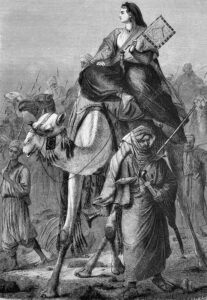
Lezingen in april
 Dinsdag 13 april
Dinsdag 13 april
Nicky van de Beek (PhD student JGU Mainz)
De wonderbaarlijke reizen van Alexine Tinne
Kosten: gratis voor donateurs van Huis van Horus, €5 voor niet-donateurs
Alexandrine Pieternella Françoise Tinne (1835-1869) was de dochter en erfgenaam van een vermogende handelaar, woonachtig in het deftige Den Haag. Naast haar passie voor fotografie hield ze er een voor die tijd ongebruikelijke reislust op na. Na de obligatoire winters in Italië en een hachelijke reis naar Scandinavië doet een griep in de Alpen haar uitwijken naar warmere oorden. Ze scheept in op een boot met bestemming Alexandrië, Egypte – een reis die de loop van haar leven zou bepalen.
Zaterdag 17 april
Professor Rosalie David
Egyptian Mummies And Modern Science
Kosten: £6
This unique facility uses medical and scientific tools to examine Egyptian mummies and humans for the physical evidence of disease, diet, medical and pharmaceutical treatments and religious practices to gain a better understanding of what life was like in Ancient Egypt. This talk will also describe current fieldwork being undertaken by the KNH Centre Missions in Egypt.
Zaterdag 17 april
Dr Joanne Backhouse (University of Liverpool)
Body Art: fashion statement or status indicator
Kosten: £5
Through this lecture Joanne will examine the manifestations of body art, both on physical remains and decorative works of art from the Predynastic to the Coptic period. The relationship between the two datasets (physical remains and decorative arts) will be analysed. The significance of the imagery will be considered to evaluate the meaning of the adornment. Until the discovery of markings on ‘Ginger’, all physical evidence from ancient Egypt was found on the female form. The only males depicted with body art in Pharonic Egypt are foreigners – Libyans.
Dinsdag 20 april
Veerle van Kersen (KU Leuven)
Linnen onder de loep: een nieuwe interpretatie van textielproductie in het oude Egypte
Kosten: €4
Textiel was millennia lang één van de belangrijkste industrieën in Egypte, en vervulde zowel tijdens het leven als in de dood een essentiële functie. Door het arbeidsintensieve productieproces was het bovendien een kostbaar goed. Deze presentatie bespreekt de verschillende stappen in de Egyptische textielproductie aan de hand van wandschilderingen en grafmodellen. We vergelijken hoe deze scènes vroeger bekeken werden, en hoe we ze kunnen herinterpreteren in het licht van de nieuwe bevindingen. Vervolgens bekijken we de textielfragmenten in Brussel en Leiden en wat ze ons kunnen vertellen over de Egyptische linnenproductie.
Maandag 26 april
Maria Nilsson & John Ward
Recent Discoveries at Gebel el-Silsila
Kosten: £5
Located some 60 km south of the grand Edfu Temple, and 65 km north of the stunning golden landscape of modern day Aswan, Gebel el-Silsila – “Kheny/Khenu” to the ancients – played an important role within the overall development of Dynastic Egypt. While the site was a vital strategic trading location, marking the boundary between Egypt and her southern neighbour Nubia, one of Egypt’s “nine bows” (chief enemies), it was first and foremost the source of a bountiful supply of prime Nubian sandstone for the building of pharaonic monuments throughout Egypt, particularly during the New Kingdom. In this lecture, Maria and John will reveal their latest New Kingdom discoveries, exploring the Temple of Sobek, the necropolis, Tutankhamun’s workers village and new finds from the quarries of Amenhotep and Ahkenaten.
Maandag 26 april
Meredith Brand
Life at a Middle Kingdom Amethyst Mine: Archaeology of Site 5, Wadi el-Hudi
Ancient Egyptian jewelry is renowned for its beauty, and the purple amethyst jewels from Middle Kingdom royal and elite burials are particularly stunning. As a luxury item, the pharaoh and his administration seemed to have exerted a state monopoly on semi-precious stones like amethyst, yet many questions remain as to how this monopoly was managed and the lives of the miners engaged in back-breaking labor.
In 2014 the Wadi el-Hudi Expedition, directed by Kate Liszka (California State University San Bernardino) and co-directed by Bryan Kraemer (Robert and Frances Fullerton Museum of Art) and Meredith Brand (The American University of Cairo), began to address these questions through surveying and excavating the Middle Kingdom amethyst mining settlements at Wadi el-Hudi in the Eastern Desert.
Maandag 26 april
Dr. Manuela Lehmann (The British Museum London)
Amara West – Lebenswelten im Nubien der Ramessidenzeit
Die seit 2009 stattfinden Ausgrabungen und Auswertungen des Amara West Projektes des Britischen Museums beschäftigen sich mit einer Siedlung und zwei zugehörigen Friedhöfen aus der Ramessidenzeit in Nubien. Die Siedlung bestand bis in die Dritte Zwischenzeit hinein und wurde dann aufgrund klimatischer Veränderungen aufgegeben.
Forschungsschwerpunkte sind unter anderem das tägliche Leben der Einwohner dieser Siedlung, die in einer Kolonie fern ab der ägyptischen Hauptstadt wohnen.
Dinsdag 27 april
Mennat-Allah El Dorry (Ministry of Antiquities)
Archaeobotanical Research in Egypt: Much Wine and a Little Fava
Since the late 19th c., the study of Egypt’s ancient flora has steadily contributed towards a clearer understanding of ancient lives and societies. Plants, after all, have been used as food, fodder, fuel, furnishings, medication, building materials, and variety of funerary and living rituals throughout Egyptian history. The production and disposal of plant products has left us a range of evidence that can be employed to make inferences about ancient lives. This talk will focus on the study of historic plant remains – archaeobotany – with reference to Egypt: its history and development, methodologies, and will present some particular case studies.
Donderdag 29 april, 18.00 uur
Peter der Manuelian (Boston)
George Reisner and the Giza Project at Harvard; studying the past with the tools of the future
Donderdag 29 april, 18.15 uur
Prof. Dr. Stephan J. Seidlmayer
“Tausend Jahre sehen auf euch herab!” Das Alte Ägypten und seine Vergangenheit. Befunde aus dem Pyramidenfriedhof von Dahschur
